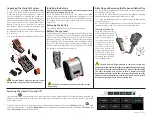
Arsenic
DOC316.53.01005
Silver Diethyldithiocarbamate Method
1
Method 8013
0 to 0.200 mg/L As
Scope and application:
For water, wastewater and seawater. Distillation is required. USEPA accepted
2
for
reporting for drinking and wastewater analysis.
1
Adapted from
Standard Methods for the Examination of Water and Wastewater
.
2
Procedure is equivalent to Standard Method 3500-As for drinking water analysis.
Test preparation
Instrument-specific information
shows all of the instruments that can make a user calibration program for this
test. The table also shows sample cell and orientation requirements for reagent addition
tests, such as powder pillow or bulk reagent tests.
To use the table, select an instrument, then read across to find the applicable information
for this test.
Table 1 Instrument-specific information
Instrument
Sample cell orientation
Sample cell
DR 6000
DR 3800
DR 2800
DR 2700
DR 1900
The fill line is to the right.
2612602
DR 5000
DR 3900
The fill line is toward the user.
Before starting
A manual calibration is necessary for this procedure, refer to
on page 5. Make a new calibration and update
the user program for each new lot of arsenic absorber solution.
Prepare the arsenic absorber solution before starting the test procedure. Refer to
on page 5.
Set up the distillation apparatus in a fume hood to prevent exposure to hazardous gas.
In bright light conditions (e.g., direct sunlight), close the cell compartment, if applicable, with the protective cover during
measurements.
Do not use the Pour-Thru Cell or sipper module (for applicable instruments) with this test.
Review the Safety Data Sheets (MSDS/SDS) for the chemicals that are used. Use the recommended personal protective
equipment.
Dispose of reacted solutions according to local, state and federal regulations. Refer to the Safety Data Sheets for disposal
information for unused reagents. Refer to the environmental, health and safety staff for your facility and/or local regulatory
agencies for further disposal information.
Items to collect
Description
Quantity
Apparatus (refer to
on page 7)
–
Arsenic Standard Solution, 1000–mg/L As
varies
Hydrochloric Acid, ACS
25 mL
1


























